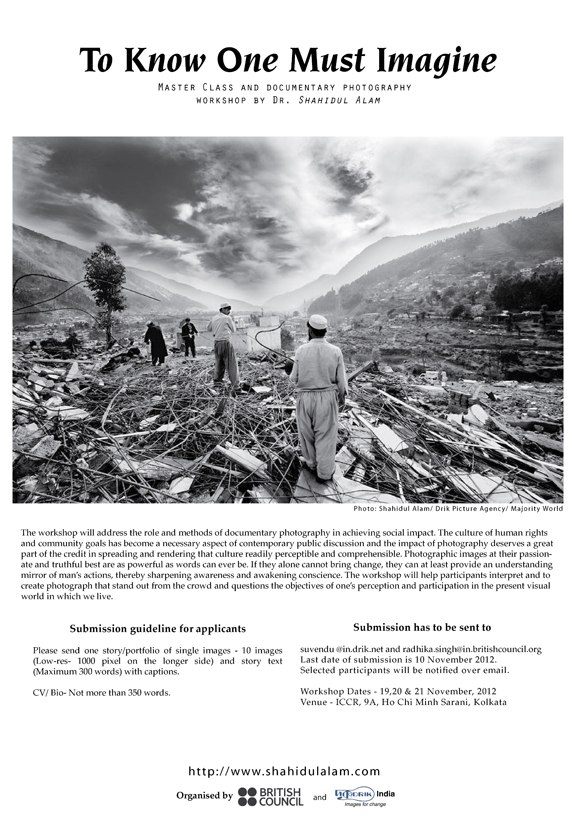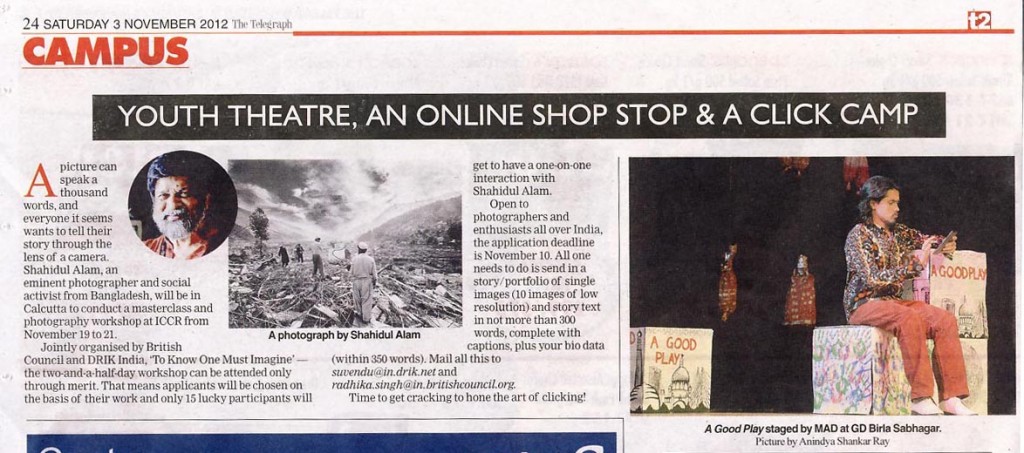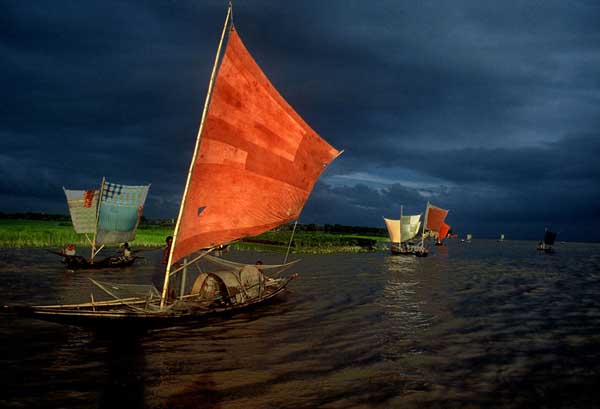|
Tag: storytelling
To know, one must imagine
Master Class and documentary photography workshop by Dr. Shahidul Alam

Dr. Shahidul Alam, eminent photographer and social activist from Bangladesh will facilitate a two and half day Master Class and documentary photography workshop titled ?Photography for social impact ? To know, one must imagine? from 19 November ? 21 November 2012 at Indian Council for Cultural Relations ( ICCR) , Kolkata.http://
This workshop is being jointly organised by British Council and DRIK India.
The workshop will address the role and methods of documentary photography in achieving social impact. The culture of human rights and community goals has become a necessary aspect of contemporary public discussion and the impact of photography deserves a great part of the credit in spreading and rendering that culture readily perceptible and comprehensible. Photographic images at their passionate and truthful best are as powerful as words can ever be. If they alone cannot bring change, they can at least provide an understanding mirror of man?s actions, thereby sharpening awareness and awakening conscience. The workshop will help participants interpret and to create photograph that stand out from the crowd and questions the objectives of one?s perception and participation in the present visual world in which we live.

Facebook link
Please Retweet #drikworkshop
Capturing The Unseen Side Of Bangladesh
Subscribe to ShahidulNews
![]()
The Picture Show NPR
08:45 am
Name a foreign country and then count how long it takes for the cliches to come rushing forth. Start with, say, Switzerland ? what first leaps to the mind are banks, chocolate and watches. Or, in the case of Brazil, it’s soccer and Carnaval. Now consider Bangladesh. If any mental picture comes up at all it probably has to do with floods and famine.
Interview on NPR
It is easy to see why those prevailing images and visual stereotypes of his homeland frustrate the heck out of Shahidul Alam. “The image of my country was built largely upon what white, Western photographers were telling,” he tells?Morning Edition host Steve Inskeep in an interview Monday.
Alam recently published a book, “My Journey As A Witness.” This collection of photographs documents a career spent not just taking beautiful pictures but producing a new set of images that enable a more nuanced way of seeing Bangladesh.
Many of his portraits are of individuals living in extreme poverty and yet the portraits manifest optimism. He speaks proudly of how the poorest of the poor in his country “manage in very difficult situations coming out with some sort of a formula for survival, which really is to be admired.”
From the Lions Point Of View
Subscribe to ShahidulNews
By Peter Marshall
From the blog >Re Photo
?Isn?t it a thrill to have him here in London? said the woman behind me to a friend as we we all waited, hardly an empty seat in the small lecture area of National Geographics?s Regent St first floor, and the next hour or so listening to Shahidul Alam talking, showing pictures and answering questions certainly justified her anticipation.

Probably most of us in the audience had some idea of the incredible transformation Dr Alam has made to the world of photography, not just in his native Bangladesh but worldwide, although so much still remains to be done, but I think all of us found there was even more to him – and his family – than we had been previously aware.
Alam?s mother in particular was a formidable woman; determined to get a university education despite the opposition of her mother-in-law to the education of women, she left home every morning in a burkha ?going to visit friends? and went to study. Armed with her degree she dedicated herself to the education of women, and having found little backing for her project, bought a tent and used it to set up her own school for girls.
Later too we heard that his father had dared to evade the ?invitation? sent to him along with the other leading intellectuals of the country to take tea with the occupying Pakistani generals in 1971 just a few days before the end of the war. It was a story accompanied by a picture by Rashid Talukdar of a severed head in rubble, from the killing fields of Rayerbazar. Altogether more than a thousand teachers, journalists, doctors, lawyers, artists, writers and engineers were massacred.
Continue reading “From the Lions Point Of View”
My Best Shot
Subscribe to ShahidulNews
Guardian 16th October 2011
Photographer Shahidul Alam’s best shot
‘The fisherman told me the river is a destructive animal. It had destroyed his home many times’

-
- Interview by?Sarah Phillips
- guardian.co.uk, Sunday 16 October 2011 22.29 BST
- Article history

In Bangladesh, there were once over 800 species of riverboats, most of which have now disappeared, largely because of the advent of motorboats and changing lifestyles. But during the monsoon, fishermen still go out to catch a particular fish called?ilish, which is a delicacy in Bangladesh. To the connoisseur, it is the ilish of this particular river that is said to be the only type that matters.
I took a fishing boat along the river from Daulatdia, but at first the light was terrible, so I decided to?wait. I stayed with a fisherman in his home, and we went out for three days. On the third day, as sometimes happens during the monsoon, there was this shaft of light that shone through a small gap in the dark cloud formation. A red sail just?happened to be there, and for several minutes became luminescent. It was absolutely a fortunate moment, but I had been waiting for it to happen.
The fisherman told me that, while the river is very much part of his?life, it is also a very destructive animal. His home, which is very close to its bank, has been destroyed many times. That didn’t deter him, though ? the river is his life. He gave me ilish to?take home, and it was as good as I’ve ever had.
We tend to think of the river as a geographical entity. I think it is much more than that: it is something that connects humanity. My picture captures a fading way of life, unique to the Bangladeshi landscape.
CV
Born: Dhaka, Bangladesh, 1955.
Influences: A man you will never have heard of, who I always see in Dhaka. He and his son are scavengers. I’ve seen him do it for years with a quiet dignity that I admire immensely.
High point: There was the time in my life when I had the choice of making an easy living and I was able to resist it.
Low point: The death of my brother when I was 15.
- Shahidul Alam: My Journey as a Witness
- Wilmotte Gallery at Lichfield Studios,
- London
- Until 18 November
- Details:020-8968?3333
- Venue website
